foxpaws

SUMMER 2022
PALM DESERT • INDIAN WELLS
Wonderfully W ild
3 From the President’s Desk
4 Conservation Impact Engaging People to Help Save Species and Restore Habitats
8 Building Connections A Vision for the Future of Education at The Living Desert

12 The Naked Truth: Everything You Didn't Know About Naked Mole-Rats

15 Introducing … Arya The black-footed cat that everyone loves to love
16 Animals in Focus: Growing Up
board of trustees
Chairman
Bill Appel*
Treasurer
Craig McCollam*
Secretary
Sandra Cooper Woodson*
President/CEO & Assistant Secretary
Allen Monroe*
Jon-Marc Blalock*
Deborah Chapman*
Marylynn Gladstein
Jim Gould
Patti Grundhofer
Candace Holzgrafe*
H. Earl Hoover II
Suz Hunt
Michael Kiner
Jaishri Mehta
Jneil Nelson
Peter Scheer
Michael M. Schreter
Dick Shalhoub
Sally Simonds
Bill Simpkins
PRESIDENT EMERITA
Karen Sausman
TRUSTEE EMERITUS
Curt Ealy
LEGAL COUNSEL
Brian S. Harnik
Roemer & Harnik, LLP
BJ Skilling
Phillip K. Smith, Jr.*
Roger Snoble
Mary Lou Solomon
Larry Spicer
Sam Spinello
Nancy L. Stegehuis*
Van Tanner
*Board of Directors
ADVISORY COUNCIL City of Indian Wells Mayor Dana Reed
City of Palm Desert
Mayor Jan Harnik and Councilman Sabby Jonathan
City of Rancho Mirage
Mayor Ted Weill
Coachella Valley Water District
Jim Barrett and Anthony Bianco
Wayne Connor Associates
Wayne Connor
Visit Greater Palm Springs
Scott White and Davis Meyer
Judy Vossler
Carol Wright
18 WildFile
20 2022 Zoobilee Gala Success
22 Events Calendar
23 Wonderfully Wild Kids
8
ON THE COVER Giraffe
Photo: Tara Howard
FOXPAWS EDITORIAL STAFF Project Manager
Erin Scott
Designer
Jim Augusto
Contributors
RoxAnna Breitigan
Dr. James Danoff-Burg
Heather Down
Jan Hawkins
Jared Moeller
Allen Monroe
Erin Scott
Lexi Ward
Angela Woods
12
contents SUMMER 2022
FEATURES
foxpaws
WHAT’S NEW
FROM THE PRESIDENT’S DESK

I RECENTLY TRAVELED to Botswana and adjoining countries, such as Namibia and Zimbabwe, with zoo directors from other Association of Zoos and Aquariums institutions. It was a chance to connect with peers, see incredible wildlife, and enjoy tranquil moments with nature. For many of us, this was the first international travel since the start of the COVID-19 pandemic, and it gave a glimpse into what travel could look like in the future.
Although everyone was vaccinated and feeling relatively comfortable about the situation, one challenge was changing protocols. One day, you needed a PCR test 72 hours or 24 hours before crossing a border. The next day, just having a vaccination card was enough. It helped being flexible, going with the flow, and having an experienced travel coordinator keeping up with each new requirement.
One thing that was obvious during our trip was the role that eco-tourism plays in animal conservation. Over the last two years, international travel for safari adventures has essentially shut down most of the camps and support services that cater to eco-tourism. At one lodge, we were the second group to visit since the start of the pandemic. Without tourism, large portions of the economy were shut down with corresponding layoffs and economic hardships.
Without a job, local people resorted to subsistence methods to feed their families including the hunting of bushmeat, often with the use of snares. Some of the conservation partners we talked to reported a substantial increase in the number of snares that were found in conservation areas. While it might be easy to be judgmental, the realities of the situation dictate that if you do not have money you will need to find a way to live off the land to feed your family.
Another revelation during our trip was that many graduate students and researchers that work on conservation projects had severe travel restrictions during the pandemic, so important work like animal census, disease detection, and community-based conservation education was curtailed. This two-year gap in learnings from these important projects will impact future planning for conservation initiatives.
So, if seeing amazing wildlife in a safari setting is on your bucket list, now is the time to fulfill that wish. You will come away with memories to last a lifetime and your visit will help to protect the animals we all care so much about.
 Allen Monroe, President/CEO
Allen Monroe, President/CEO

For information on traveling with Allen, visit LivingDesert.org/Travel foxpaws | SUMMER 2022 3
Left: At Victoria Falls.
Right: In front of an ancient baobab tree.
Conservation Impact
ENGAGING PEOPLE TO HELP SAVE SPECIES AND RESTORE HABITATS
BY DR. JAMES DANOFF-BURG, DIRECTOR OF CONSERVATION
As I've said many times, species are quickly declining and their habitats are rapidly worsening, but not because they have forgotten how to eat, breed, and thrive! Species are in decline because of our activities as humans, which include altering or clearing the habitats in which nature lives, introducing non-native species that change ecosystems, overhunting, pollution, climate change, and altering how our planet functions. Our impact is massive and global, and we are all contributing. And yet, we can all do better to engage people to help us save species and restore habitats.
The precipitous decline of species we are currently experiencing is over 1,000 times normal and is nearly equal to the extinction event that wiped out the dinosaurs and over 75% of all other species that were on Earth when that asteroid struck off the coast of the Yucatan Peninsula 65 million years ago. So, our impact now is akin to an asteroid 9 miles in diameter smashing into our planet—producing a nuclear-winter situation that lasted for potentially thousands of years!
People are the root cause of conservation problems. However, people can also be the solution. At The Living Desert, our conservation work has many facets. On grounds, we work to educate our guests about the challenges facing the world’s desert wildlife and wild places and inspire them to act.
The Conservation team does in-the-field work, as we seek to address the root causes of species decline and not just the symptoms. We work with
communities around the world so that we can all live sustainably alongside nature and repair human-caused damages to habitats in Southern California.
RESTORING ECOSYSTEMS
Our more traditional conservation work strives to restore habitats across Southern California for the benefit of many endangered animal species using a wide array of approaches to repair these human-caused damages. By enriching and restoring habitats, it is more likely that all the native species will survive.
Many of these projects are focused on growing the plants that need to be outplanted into the habitats in need of restoration. For example, one project involves removing water-hungry invasive plants which collectively dry out the rare creeks in which the desert pupfish lives and by planting native plants. Secondly, we replant native species that have vanished due to off-road vehicle use and climate change for the benefit of the
4 foxpaws | SUMMER 2022
desert tortoise. A third approach is where we are assessing the viability of habitats in terms of having the forage plants and water sources that would enable us to bring back the Desert Ghost—the Sonoran pronghorn—which has been missing for over 80 years! The last of these project types is when we create naturalistic habitats in highly disturbed human-dominated urban areas, which involves planting native pollinator gardens and native street trees that benefit all the birds, lizards, mammals, and insects that rely upon them for resources.
All this biologically-based work directly benefits the entire ecosystem, not just the animal species that we are striving to benefit. It is immensely gratifying to see a functioning ecosystem thrive in an area that was just a shell of its original self because of our work. There are many individuals who contribute time, skills, and effort to these projects including our passionate staff and volunteers.
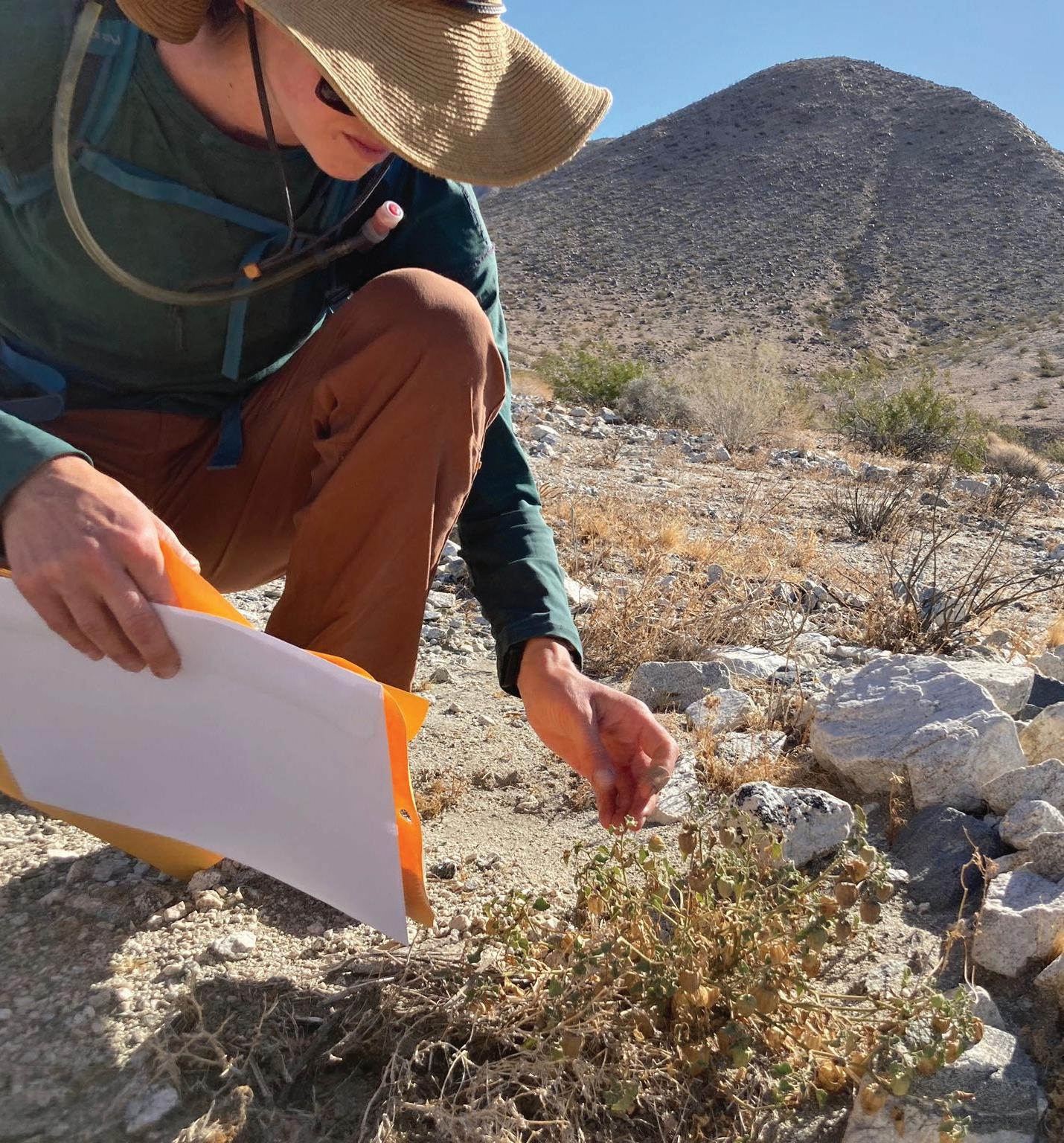
MAKING A LASTING IMPACT
Our second approach is focused exclusively on sharing the many ways that we can all change our behavior to

foxpaws | SUMMER 2022 5
Above: Assessing plant biodiversity in the Orocopia Mountains for the desert tortoise. Below, right: One project involves removing water-hungry invasive plants that humans brought here which collectively dry out the rare creeks in which the desert pupfish lives.
The precipitous decline of species we are currently experiencing is over 1,000 times normal and is nearly equal to the extinction event that wiped out the dinosaurs and over 75% of all other species.
benefit nature and the huge impacts we can all have by doing so. Across Southern California, The Living Desert’s Time to Talk Trash campaign encourages people to properly dispose of and contain their organic waste for the benefit of the desert tortoise. Ravens eat our trash and thanks to it, their populations in some areas are over 1,800% more than what they were only a few decades ago. These ravens then eat everything living that they can: birds, lizards, and young desert tortoises. We launched our Gold Star Restaurant Program in the Hi-Desert cities on the north side of Joshua Tree to encourage people to support those restaurants that actively close their dumpsters and deny extra food to ravens. This program is helping to allow raven populations to return to lower, more natural levels, thereby reducing raven predation on desert tortoises and other wildlife.
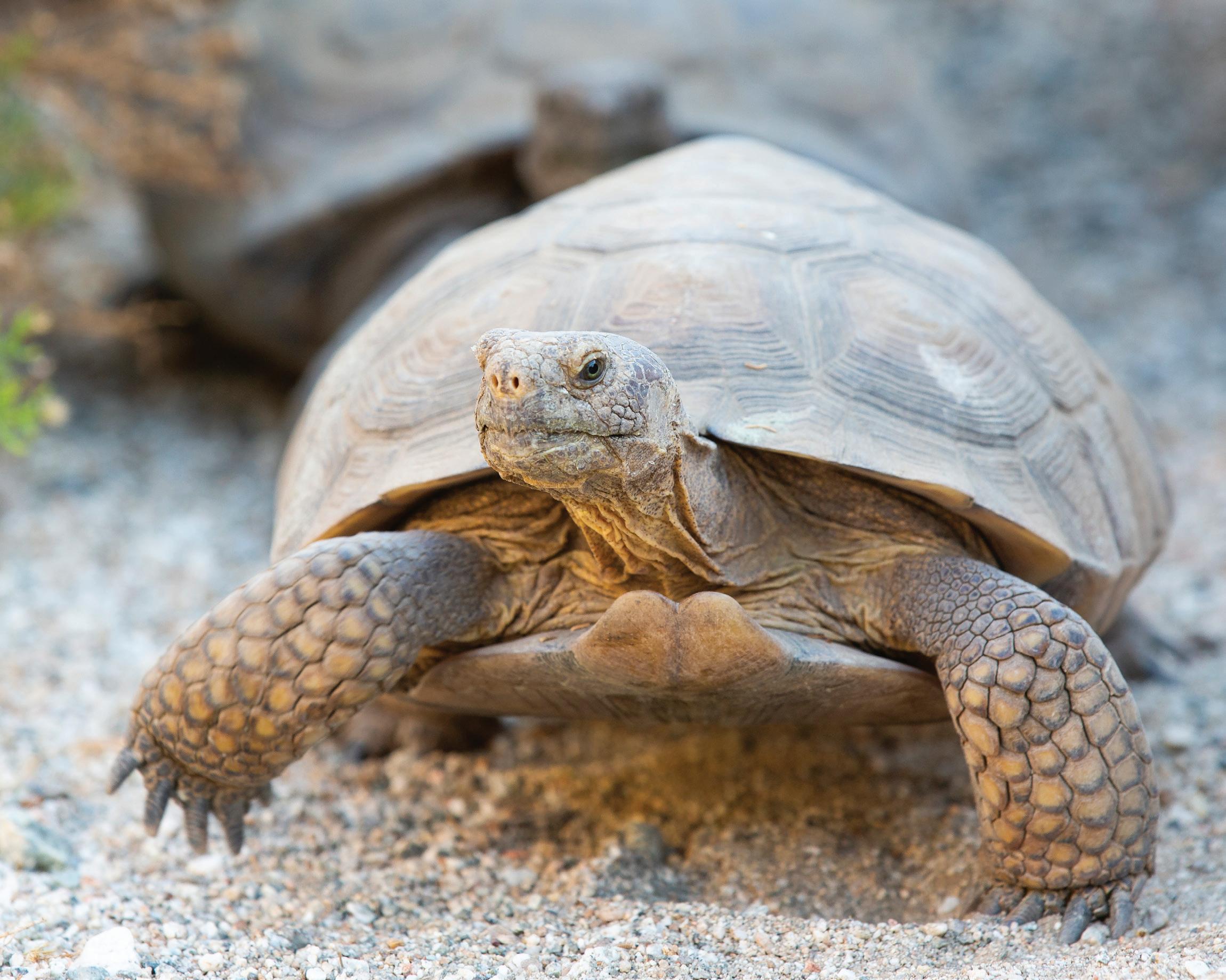
You cannot improve what you cannot measure. By sharing our social science expertise, our international collaborators and partners have been taught how to evaluate the success of their community engagement projects. Many of our partners, including Grevy’s Zebra Trust in Kenya, Wild Nature Institute in Tanzania, Painted Dog Research Trust in Zimbabwe, and the Black Mambas Anti-Poaching Unit in South Africa, have all employed our social science evaluation skills to gauge
the behavior change outcomes of their programs and initiatives.
Furthermore, The Living Desert’s Building Community Conservation Success (BCCS) social science training workshops have significantly changed the way conservation engagement happens. I am very proud of the success of these workshops; they are one that I consider to be one of my greatest professional accomplishments.
The BCCS workshops are for field conservationists who understand the need to work with communities in order to address the root causes of the issues facing wildlife. Most conservationists are biologists who are passionate about animals. Biologists expect to work with animals, however, in the field it is clear
6 foxpaws | SUMMER 2022
We replant species that have vanished due to off-road vehicle use and climate change for the benefit of the desert tortoise.
that people need to be the main focus of effective field conservation. The week-long workshops teach the conservationists the essential bases of how to learn from their communities as to how to best encourage pro-environmental behavioral change. Despite the challenges of COVID, The Living Desert’s Building Community Conservation Success program has trained 356 people from 29 countries!

Conservation is full of challenging problems, almost all of which are rooted in human behavior and require us to alter our actions to have less of an impact on the world. Saving species requires all of us to collaborate and we all have a role to play. We are fortunate to have been able to collaborate with so many incredible organizations from around the world to help engage people to save species and restore habitats!

foxpaws | SUMMER 2022 7
Left: We provide services to our international collaborators, such as the Black Mambas Anti-Poaching Unit, to share our social science skills to assess how successfully their community engagement projects have changed behavior.
Below: Building Community Conservation Success social science training workshops are for field conservationists who work with communities to address the root causes of species decline.
We need to ensure that our participants are engaged and actively gaining hands-on experiences.

8 foxpaws | SUMMER 2022
Building Connections
A Vision for the Future of Education at The Living Desert
DR. ANNA YOUNG, DIRECTOR OF EDUCATION ENGAGEMENT
When I attended the Association of Zoos and Aquariums (AZA) conference in April, a phrase I heard repeatedly was, “We were doing XYZ … and then COVID happened.” I’m sure that’s a familiar phrase for many of us here as well.
As The Living Desert’s new Director of Education Engagement, I am fortunate to begin my role in a (mostly) post-social distancing world. As we look to rebuild our educational offerings, I have been thinking about the future of education from a 30,000-foot vantage point. Like so many of our AZA peers, education programming and offerings were put on hold for most of the last two years. I’m
eager to create new programming, but I also realize how important it is to take time to learn about The Living Desert and Coachella Valley so I can be intentional about what we bring back, and what we leave behind from before the pandemic.
From my perspective, zoo education is first and foremost about conservation education, and conservation education is about behavior change. Psychologists have coined the term the ‘GI Joe fallacy’ to refer to when people mistakenly assume that knowledge is half the battle. We so often wish that once someone learns about the thing we care about, they’ll care about it too, but psychology has taught us
that it takes more than awareness to inspire change. As a scientist, I prefer to take an evidence-based approach to all matters, including teaching and learning, which aligns perfectly with The Living Desert’s goal of being a data-driven nonprofit. If we venture into education the same way we would a science project—experiment with several new ideas and evaluate the results—that means in the coming months we’ll be testing various kinds of programming, and some of those ideas will continue, while others are phased out.
I plan to expand our education programming in a way that is asset-based: teaching people
foxpaws | SUMMER 2022 9
positive impact behaviors (what to do instead of what not to do), uniting them within a community to inspire change, and empowering guests with a sense of agency to act for conservation. We’re also working alongside our Conservation team to create programming and engagement opportunities that build future agents of conservation.
The best programming is cocreated with, not for, communities, by meeting people where they are—literally, during neighborhood outreach events, or at the zoo by addressing a family’s needs while they are visiting. We’ve started making small changes towards this by expanding our
ZooCamp summer check-in hours to encompass wrap-around care, such that parents who work at 8am can drop their kids off at ZooCamp and still make it to work on time. Our newly expanded Education team now has four bilingual staff members who can present programming in Spanish to increase inclusion and accessibility.
In a world of Google and computers in our pockets, innovative education isn’t about spouting facts as much as making meaningful connections. These connections can still occur virtually to reach audiences who wouldn’t be able to make it to The Living Desert, but they should rely on education through storytelling—not
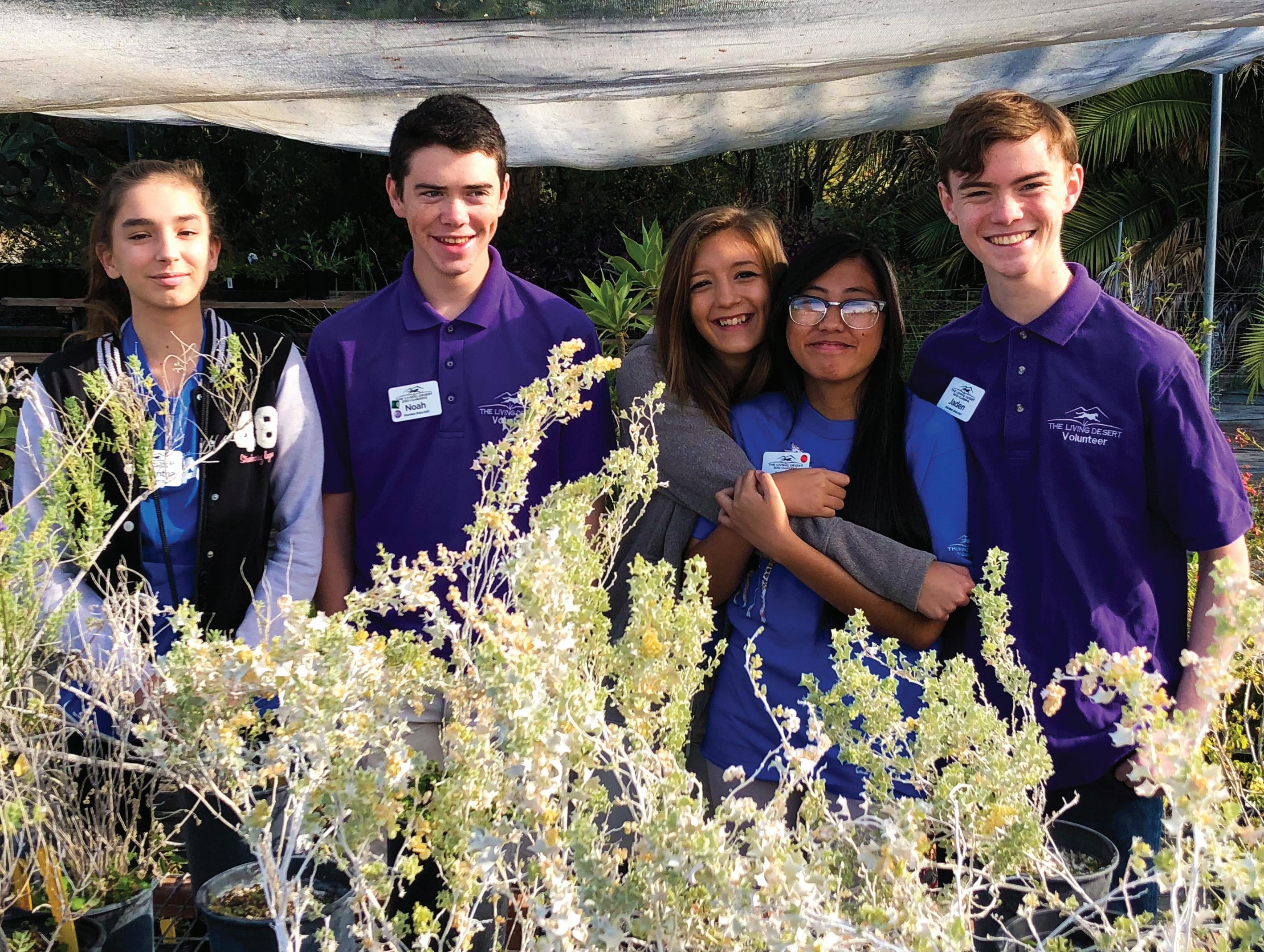
only is storytelling more engaging, but research also shows that people are more likely to retain stories than crumbs of information off the block of knowledge. Above all, education should be learner-centered. This means it doesn’t matter how active, enthusiastic, or excited our educators are, we need to ensure that our participants are engaged and actively gaining hands-on experiences. This is already at the center of our ZooCamp programs and will be a useful lens for us to use to evaluate all our potential future programming.
Zoo education also plays a part in people’s development throughout life, from early childhood education to teacher support of
10 foxpaws | SUMMER 2022
Zoo education plays a part in people’s development throughout life, from early childhood education to K-12 classes, to adult programs and volunteering after retirement.
Next Generation Science Standards, family programs and STEM career preparation for teen volunteers, as well as adult programs and volunteering after retirement. I am excited to try out new adult programming such as book clubs and mystery-themed events that center around animals and STEM practices—imagine learning about how conservationists use eDNA to detect species presence while enjoying wine and solving a Zoo Scene Investigation!
Ultimately what zoo education uniquely has to offer is the joy and wonder of watching wildlife and internalizing knowledge from head to heart, and this will be at the center of how we connect people and share stories.

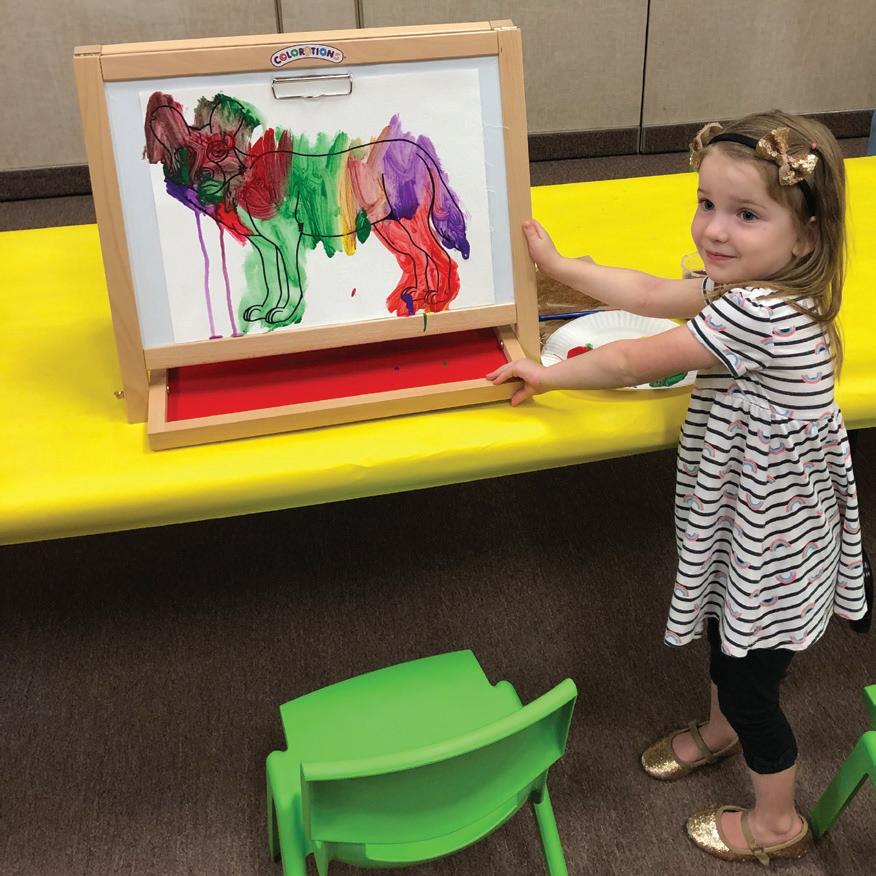

foxpaws | SUMMER 2022 11
The best programming is co-created with, not for, communities, and by meeting people where they’re at--in their neighborhoods.
the naked truth:
mole-rats
 BY JARED MOELLER, ANIMAL CARE CURATOR
BY JARED MOELLER, ANIMAL CARE CURATOR
12 foxpaws | SUMMER 2022
everything you didn’t know about naked
if i asked you,
what is the most interesting animal to call The Living Desert’s Rhino Savanna habitat home, what would you answer? The black rhinoceros with its giant frame and prehistoric look? Would it be the small but wiry dwarf mongoose? What if I said it is the naked mole-rat?
The first thing that makes naked mole-rats interesting is that their entire name is somewhat a lie. First, they are not completely naked, they have whiskers and 100 tiny hairs spread around their body allowing these effectively blind animals to feel their way through their pitch-black homes. Second, they are not related to moles at all. Finally, though they are rodents, they are not rats, in fact they are more closely related to porcupines and guinea pigs.
PHYSIOLOGICAL MARVELS
There are so many fascinating elements about naked mole-rats, it is tough to know where to begin, but perhaps it is best to start with their unique physiological traits. Mole-rats have an extreme tolerance to pain. Certain pain receptors have genetically been “turned off,” effectively meaning they do not feel certain types


of pain—they do not feel the effects of acids or even chili peppers. Even lactic acid build-up in their muscles does not affect them like it does us, allowing them to live comfortably in their low oxygen, high carbon dioxide tunnels miles below the surface.
Mole-rats are incredibly long-lived animals, living into their 30s—which is about the same as black rhinoceros! This is a remarkable trait as smaller animals tend to live shorter lives overall. Living this long is even more impressive because mole-rats are one of the few mammals that do not regulate their body temperature— hence why you can find them sleeping in a big pile. They heal remarkably fast; we often find minor injuries heal in just one day. Due to these traits naked mole-rats are a highly studied species, in particular for cancer research. Mole-rats seem to be almost completely resistant to cancer as they rarely, if ever, develop the disease.
Incredibly, every naked mole-rat you see in one of our two colonies is essentially a clone. Though they are not clones in the traditional sense, like Dolly the sheep, colony members are so inbred that, genetically speaking, they are basically clones. For most species, this level of
foxpaws | SUMMER 2022 13
every mole-rat you see in one of our two colonies is essentially a clone.
Mole-rats are one of the few mammals that do not regulate their body temperature.
inbreeding would become highly detrimental, but for some reason, naked mole-rats seem resistant to the ill effects and exist this way naturally.
SOCIAL STRUCTURE

Naked mole-rats almost have more in common with insects than they do other mammals. They are eusocial animals, which means their social lives are similar to termites and bees. Mole-rat colonies revolve around one singular female, known as the queen. This queen does all the breeding for the entire colony and can usually be identified as she is significantly larger than all the other rats, owing to the fact queens grow longer each time they have a litter of pups. Each colony has 2-4 drones who are the males that breed with the queen. The rest of the colony is made up of workers who are responsible for pup care, expanding the tunnels, and foraging for food. Colonies of naked mole-rats also have a caste of soldiers who are tasked with defending the colony; soldiers are slightly larger than workers with thicker necks and jaws. Lastly, there is a rare type of naked mole-rat born into colonies called a dispersiform, who does not take part
in daily activities of the colony and will eventually be a rare immigrant to a new colony.
THE GAME OF THRONES
Queen mole-rats are not benevolent rulers; the only way a new queen is crowned is through fighting. If a queen dies the most dominant females will soon fight for the “crown,” the winner often killing the other challengers. However, even a healthy queen is not completely safe from usurpers as any female may challenge the queen for power at any time. Challengers may even have loyal subjects who will help them spark a civil war to take over. A former queen’s allies may even cause trouble after a new queen takes over.
Basically, Game of Thrones might as well have been about naked mole-rats! All this political intrigue makes minor conflicts among colony members quite common, and the Rhino Savanna team monitors these conflicts closely. But as mentioned previously, even though their fights can look really bad, they are the toughest animals on Rhino Savanna. On your next visit, consider taking a closer look at these magnificently unique creatures.
14 foxpaws | SUMMER 2022
INSIDE LOOK!
The naked mole-rat habitat is connected by a series of tunnels.
INTRODUCING … Arya
Social media star, Arya the black-footed cat, is now four months old and continues to thrive after surgery in April, thanks to the life-saving care provided by The Living Desert's expert animal care and veterinary teams. For those new to her story, at two-weeks old she suffered a lifethreatening injury and was quickly brought under the expert care of the veterinary team who worked tirelessly and passionately to help her heal.
Today, Arya is learning to be more independent, as is natural for her age, and has moved into a behind-the-scenes habitat. She continues to meet all of her developmental milestones and is learning socialization skills alongside other animals, including fellow black-footed cats. We are excited to share that she now weighs one kilogram; a small weight but a big success, as adult black-footed cats weigh between 1-2.5 kilograms.

Though small and undeniably adorable, black-footed cats are fierce and adept hunters, with a predation success rate of 60%! Black-footed cats are a vulnerable species, as categorized by the IUCN Red List of Threatened Species, and Arya's birth was the result of a Species Survival Plan (SSP®) recommendation to ensure genetic diversity and sustainability in the human care population of black-footed cats.
Continue to check in on Facebook, Instagram, and TikTok to see updates on this fierce, little warrior.
foxpaws | SUMMER 2022 15
THE BLACKFOOTED CAT THAT EVERYONE LOVES TO LOVE.
Growing Up
Bighorn sheep Walk within an hour of birth.

Yellow-footed rock wallaby Stay in their mother’s pouch for up to 6 months before fully emerging!

Black rhino Rhino calves can stay with their mothers for 2-3 years.
Giraffe During birth, a calf drops nearly six feet to the ground.

Cape porcupine Their signature quills begin to harden within a few days of birth.
Worth the
Newborn Milestones Weight
From less than an ounce to over 100 pounds, these newborns all have some growing to do once they enter the world.
Bennett’s wallaby
At Birth: .04 oz
At Maturity: 24-40 lbs
Black-footed cat
At Birth: 2-3 oz
At Maturity: 2.5-5.5 lbs
African painted dog
At Birth: 8-10 oz
At Maturity: 50 lbs
Warthog
At Birth: 1-2 lbs
At Maturity: 200-250 lbs
16 foxpaws | SUMMER 2022
Animals in Focus
Gestation & Incubation Periods
White ibis
21 days
Bennett's wallaby
29 days*
Meerkat 70 days
Naked mole-rat
70 days
African painted dog
80 days
Desert tortoise
120 days
Addra gazelle
150 days
Bighorn sheep
177 days
Black rhino
At Birth: 75-110 lbs
At Maturity: 1,700-3,000 lbs
Giraffe
At Birth: 125-150 lbs
At Maturity: 1,500-3,000 lbs
Marsupials like the Bennett’s wallaby are born underdeveloped; moments after birth, they crawl into their mother’s pouch where they fully develop for about six more months.

Black rhino
450 days
Many baby animals have a variety of unique monikers.
foxpaws | SUMMER 2022 17
0 6 months 12 months 18 months
It’s All in the Name kit Fennec fox puggle Echidna piglet Warthog owlet Owl porcupette Porcupine
WILDFILE
ENJOY THE WONDER OF THE WORLD’S WILDLIFE, LIKE NEVER BEFORE
Embark on the journey of a lifetime with The Living Desert Travel Club. These excursions offer unique opportunities and up-close encounters with the breathtaking beauty, flora, and fauna of each destination.
Trips are hosted by Allen Monroe, President/CEO of The Living Desert, who brings his years of knowledge and background in travel, biology, and conservation to create an unforgettable experience.
Space is limited. Learn more about upcoming trips at LivingDesert.org/Travel or by calling Lexi Ward at (760) 340-2157.
GREENLAND AND THE CANADIAN HIGH ARCTIC

September 7-26, 2022
Navigate spectacular fjords and glaciers, hike along iceberg paths rarely visited by humans, look for wildlife, and visit Viking ruins on this epic exploration through two of the Arctic's most magnificent places: Canada's High Arctic and Greenland.
BOTSWANA
October 1-12, 2022
Adventure meets luxury in this expedition through the various island forests and grassy floodplains of Botswana, as you join in extraordinary encounters with the land’s diverse and prolific wildlife.

TANZANIA
June 6-16, 2023
Discover infinite beauty as you follow in the historic footsteps of writers and explorers, then experience the thrill of spotting wildlife like hippos, rhino, giraffe, lion, cheetah, and more.
INDIA
October 22 – November 4, 2023
Journey into the heart of wild India to see its cultural treasures, resplendent national heritage, conservation legacy, and of course, look out for wildlife like barasingha deer, Indian bison, langur monkeys, sloth bear, and the elusive Bengal tiger!

18 foxpaws | SUMMER 2022
Greenland Glacier
Botswana Elephant
Bengal Tiger
JAN HAWKINS STEPS INTO NEW ROLE AS DAVID CHALFANT JOINS AS DIRECTOR OF DEVELOPMENT
After a successful seven-year tenure as The Living Desert’s Director of Development, Jan Hawkins has transitioned into semi-retirement with a new role at the Zoo working to steward philanthropy through leadership and legacy giving. Since 2015, Jan has led the organization’s fundraising efforts, securing more than $50 million dollars through the Pride of the Desert Capital Campaign, estate and legacy gifts, and community support.
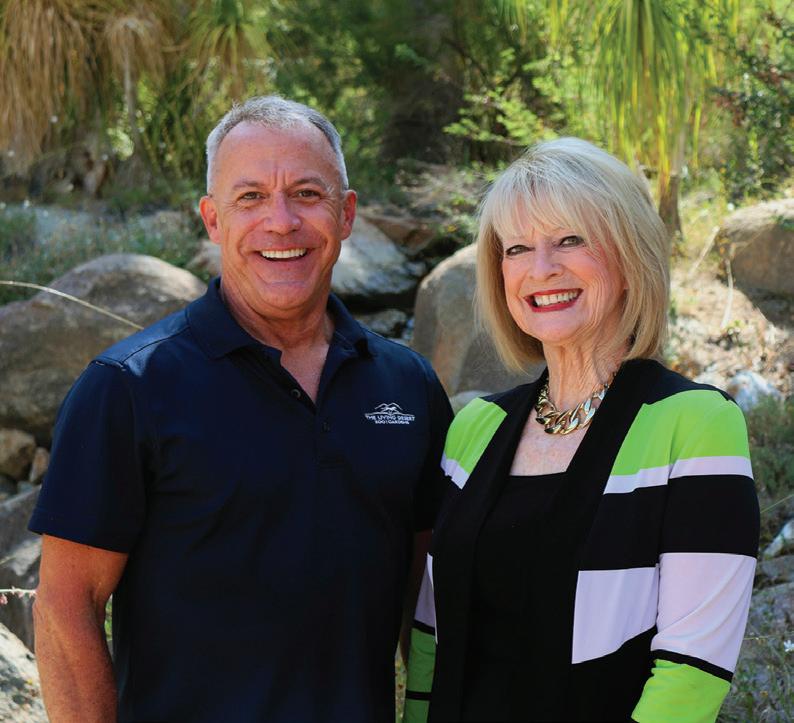
“As I embark into this next phase, I am delighted to continue helping our donors realize their most impactful contributions to a cause they care about deeply through Leadership and Legacy Giving,” shared Jan. “My time at The Living Desert has been nothing short of amazing, and it has been such an honor to work with so many passionate supporters of The Living Desert.”
After a nationwide executive search, David Chalfant has been hired as The Living Desert’s new Director of Development to lead the organization’s fundraising and development initiatives. He has extensive national and international fundraising experience, with expertise in strategic messaging, marketing, and fundraising growth. David hails from Washington D.C. and has been visiting the Coachella Valley since 1988. Returning to the valley to work in conservation is a “dream come true.”
WELCOMING DR. ANNA YOUNG AS DIRECTOR OF EDUCATION ENGAGEMENT
Anna Young, PhD, recently joined The Living Desert Zoo and Gardens as the Director of Education Engagement. In this role, she leads the zoo's education programming, adult and teen volunteer programs, and conservation education initiatives.
Prior to joining The Living Desert, Dr. Young was an Associate Professor and Director of the Zoo and Conservation Science Program at Otterbein University in Westerville, Ohio. She earned her Bachelor of Science degree in Ecology and Evolutionary Biology from the University of Arizona, and her PhD in Ecology and Evolutionary Biology from New Mexico State University.

foxpaws | SUMMER 2022 19
Mamma Mia! savethe
It was a Wild Time!
BY JAN HAWKINS, LEADERSHIP GIFTS & LEGACY GIVING AND LEXI WARD, ANNUAL GIVING OFFICER PHOTOGRAPHY BY LANI GARFIELD AND MARC GLASSMAN
Blustery conditions couldn’t keep a sold-out crowd of 350 guests from celebrating “Wild Times” at the Zoobilee Gala in support of animal care and conservation at The Living Desert Zoo and Gardens. Adorned in bright colors and animal prints, guests paid $1,000 per person to help raise more than $1.4 million to protect desert wildlife.
The festivities began with a cocktail reception in Living Legacy Garden complete with live animal encounters, unique “wild” caricatures on stilts, and the signature drink—the watermelon Rhinotini. Guests soon transitioned into the colorfully decorated pavilion— created by Frank Goldstin’s Momentous Events production company—for a three-course dinner by Carousel Catering. A meaningful program was hosted by The Living Desert President and CEO Allen Monroe, highlighted with honoring Board Member Larry Spicer for nearly 40 years of dedication and commitment to The Living Desert.
Big-hearted guests “raised their paws” to offer donations, followed by the exciting Live Auction. Board member Jim Gould and his wife Susan were the successful bidders to name the 10-day old female giraffe calf, choosing the name Cole, in honor of their late son. They will also be treated to a VIP behind-thescenes experience of the Giraffe Barn and Savanna.
Board member Jaishri Mehta and husband Raju generously provided a $30,000 opportunity to choose a diamond bauble from their store, El Paseo Jewelers, to be
enjoyed by winners Sharon and Dean Baltzell at a private party with 10 of their special guests. Other exclusive live auction items included “Lunch with Nia the Rhino,” including being the first guests to give our female rhino a scratch behind the ears; an “Evening Safari” with Allen Monroe with a behind-the-scenes expedition through the Zoo including private feedings with Australian budgies, emus, and wallabies, as well as a special meet and greet with the rhinos and giraffe; and a private dinner for 16 people in the wine cellar at Toscana Country Club. After the auction, all the dancing queens were out of their seats for the rest of the evening with the well-loved songs played by ABBAFAB, an ABBA tribute band.
A special thank you to the 2022 Wild Times Zoobilee Gala Co-Chairs Dennis Flaig-Moore and Nancy Stegehuis and their Gala Committee, including Suzan Appel, Sharon Baltzell, Jon-Marc Blalock, Deborah Chapman, Marylynn Gladstein, Jaishri Mehta, Davis Meyer, Jneil Nelson, Mary Lou Solomon, Susan Stein, Sandy Woodson, and Frank Goldstin of Momentous Events.
Additional gratitude goes to our generous sponsors including Diamond Sponsor JoAnn McGrath and the Highland Street Foundation; Platinum Sponsors: Argyros Family Foundation, Sharon and Dean Baltzell, Susan and Jim Gould, Sally and Michael Schreter, and the Gordon W. and Ursula I. Johnson Trust; and Gold Sponsors: City of Rancho Mirage, Connie and Bob Lurie, Shirley A Smith, Steven Tobin, Johnny Krupa and the Grace Helen Spearman Charitable Foundation, and Rita Stec and Lance Eldred.
20 foxpaws | SUMMER 2022
date forour nextga l a !














 Linda Rider, Marge Barry, Bob Archer, and Chuck Hilliar
Bill Appel, Larry Spicer, and Allen Monroe Walter and Geri Clark
Andy and Marylynn Gladstein Susie and Wayne Harvey
Stacy Schlinger, Sharon Baltzell, Wendy Cox, Lori Hemighaus, and Donna Ward
Ted and Jenny Weill Suzan and Bill Appel
Brooke and Dan Koehler
Steve and Anne Furgal and Allen Monroe
Dick Shalhoub and Tracy Smith
Nancy Stegehuis and Dennis Flaig-Moore
Jim and Cynthia Williams Sharon and Dean Baltzell Larry and Patty Spicer
Linda Rider, Marge Barry, Bob Archer, and Chuck Hilliar
Bill Appel, Larry Spicer, and Allen Monroe Walter and Geri Clark
Andy and Marylynn Gladstein Susie and Wayne Harvey
Stacy Schlinger, Sharon Baltzell, Wendy Cox, Lori Hemighaus, and Donna Ward
Ted and Jenny Weill Suzan and Bill Appel
Brooke and Dan Koehler
Steve and Anne Furgal and Allen Monroe
Dick Shalhoub and Tracy Smith
Nancy Stegehuis and Dennis Flaig-Moore
Jim and Cynthia Williams Sharon and Dean Baltzell Larry and Patty Spicer
EVENTS CALENDAR SUMMER/FALL 2022
PRIVATE SAFARI TOURS
Sit back and enjoy your guided, 2-hour private safari tour. Explore the zoo’s main pathways and features, while also getting an in-depth look at the flora and fauna that make the deserts of the world so special. Tours are offered daily for small or large groups. Advanced reservations are required, and fees apply. Learn more at LivingDesert.org/Tours. Book your tour by calling (760) 346-5694.
GIRAFFE FEEDING
Come face-to-face with the world’s tallest animal and make memories to last a lifetime.

Through September 30, offered daily from 8:00am-12:00pm.
Members: $6 / Non-members: $8
Beginning October 1, offered daily from 9:00am-3:00pm.
Members: $6/ Non-members $8
NEW VOLUNTEER ORIENTATION - AUGUST 17
Learn more about how you can support The Living Desert through volunteering. A variety of positions and shifts are available. Advanced registration is required: Volunteer@LivingDesert.org.
SEASON HOURS RETURN – OCTOBER 1
The Living Desert returns to regular seasonal hours, open from 8:00am-5:00pm daily, with last admission at 4:00pm. The hiking trails and carousel also resume regularly scheduled operation.
HOWL-O-WEEN – OCTOBER 29-30
The Living Desert’s Howl-O-Ween returns with new features, programs, and fun. Stay tuned for more information.
WILDLIGHTS
SELECT NIGHTS, NOVEMBER 23- DECEMBER 30
The Living Desert’s beloved holiday tradition returns for its 30th Anniversary. Tickets will go on sale mid-September; stay tuned for more details and information.

AUG 2022 OCT 2022 NOV-DEC 2022 OFFERED DAILY
Giraffe Feeding
WildLights
Kids Wonderfully Wild
Desert Adaptations

All of these animals have adapted to live in a harsh desert climate. Can you match the animal to its adaptation?


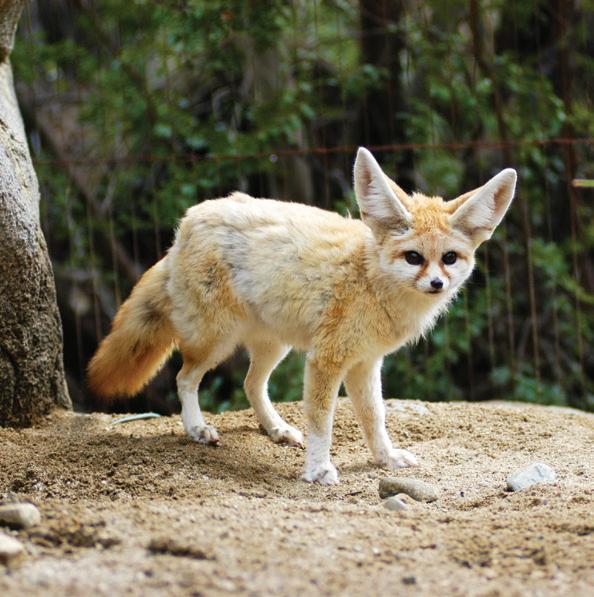


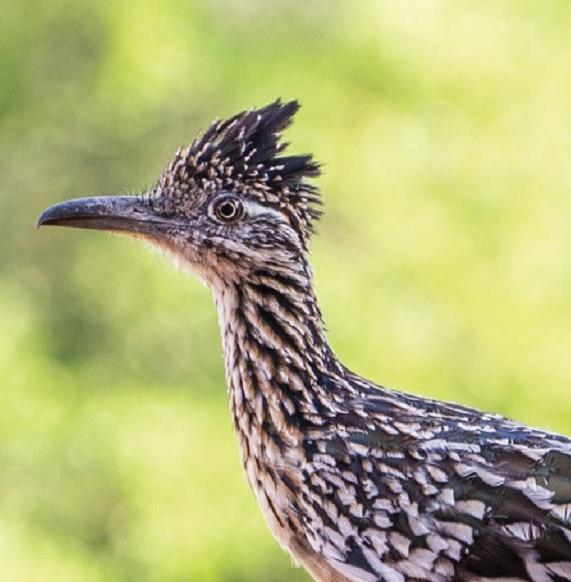

A. Swims through sand
b. Cries out excess salt tears
c. Sun-Reflecting Coat
d. Mud Sunscreen
e. Ears that Cool
f. Can store water in its bladder
g. Built-in Sunglasses
H. Stores food on its back
1. Addax
2. fennec fox
3. meerkat
4. desert tortoise
5. camel
6. Fringe toed lizard
7. roadrunner
8. black rhino
Answers:1c, 2e, 3g, 4f, 5h, 6a, 7b, 8d 1.___ 2.___ 3.___ 4.___ 5.___ 6.___ 7.___ 8.___
JOIN OUR PACK!

We want to thank all of our new and renewing members who have supported us this past season. Year after year, your membership provides The Living Desert with a reliable and renewable source of support. You help give our animals and gardens the best possible care and help support our mission of desert conservation through preservation, education, and appreciation.
Observing some of the world’s endangered desert plants and animals in a natural setting is truly a unique experience. In the coming season, we hope you can enjoy the many valuable member benefits that come with being a member of The Living Desert. Not a member yet? Join today!
NON-PROFIT ORG. US POSTAGE PAID PERMIT NO.149 PALM DESERT, CA
47900 Portola Ave. Palm Desert, CA 92260
African painted dog





 Allen Monroe, President/CEO
Allen Monroe, President/CEO











 BY JARED MOELLER, ANIMAL CARE CURATOR
BY JARED MOELLER, ANIMAL CARE CURATOR



























 Linda Rider, Marge Barry, Bob Archer, and Chuck Hilliar
Bill Appel, Larry Spicer, and Allen Monroe Walter and Geri Clark
Andy and Marylynn Gladstein Susie and Wayne Harvey
Stacy Schlinger, Sharon Baltzell, Wendy Cox, Lori Hemighaus, and Donna Ward
Ted and Jenny Weill Suzan and Bill Appel
Brooke and Dan Koehler
Steve and Anne Furgal and Allen Monroe
Dick Shalhoub and Tracy Smith
Nancy Stegehuis and Dennis Flaig-Moore
Jim and Cynthia Williams Sharon and Dean Baltzell Larry and Patty Spicer
Linda Rider, Marge Barry, Bob Archer, and Chuck Hilliar
Bill Appel, Larry Spicer, and Allen Monroe Walter and Geri Clark
Andy and Marylynn Gladstein Susie and Wayne Harvey
Stacy Schlinger, Sharon Baltzell, Wendy Cox, Lori Hemighaus, and Donna Ward
Ted and Jenny Weill Suzan and Bill Appel
Brooke and Dan Koehler
Steve and Anne Furgal and Allen Monroe
Dick Shalhoub and Tracy Smith
Nancy Stegehuis and Dennis Flaig-Moore
Jim and Cynthia Williams Sharon and Dean Baltzell Larry and Patty Spicer


















